

Jon Clements, Author (unless otherwise noted) and Editor
| Coming events | Degree days (Base 43 BE) |
| Apple maggot 1st oviposition punctures | 1605-2157 |
| Codling moth 2nd flight start | 1571-2245 |
| Lesser appleworm 2nd flight start | 1412-2090 |
| Obliquebanded leafroller 1st flight subsides | 1619-2045 |
| Oriental fruit moth 2nd flight peak | 1444-1960 |
| Redbanded leafroller 2nd flight peak | 1528-1986 |
| San Jose scale 2nd flight start | 1629-1979 |
| STLM 2nd gen tissue feeding mines present | 1378-2035 |
*adapted from Scaffolds Fruit Journal
Note: this will be the last Upcoming pest events for 2016.
Key insect life cycle and management dates (and some disease and horticuluture stuff)
Note: for 2016, we have five Massachusetts orchard locations subscribed to AR: Belchertown, Easthampton, Deerfield, Groton, Phillipston, and Sutton. The website for looking at AgRadar for these locations is: http://extension.umaine.edu/ipm/ag-radar-apple-sites/. What follows is for the Belchertown location.
Apple Maggot Fly (AMF) -- Rough guess of date first apple maggot flies are caught on traps is: Tuesday, June 28. Rough guess of peak AM trap captures is: August 2, Tuesday.
Dogwood Borer (DB) -- first egg hatch roughly: June 19. Peak hatch roughly: July 26
Codling Moth (CM) -- Codling moth development as of July 12: 2nd generation adult emergence at 3% and 1st generation egg hatch at 99%. 2nd generation 7% CM egg hatch: July 25, Monday, = target date for first spray where multiple sprays needed to control 2nd generation CM. 2nd generation 30% CM egg hatch: August 3, Wednesday, = target date where one spray needed to control 2nd generation CM.
Obliquebanded Leafroller (OBLR) -- Optimum sample date for late instar summer generation OBLR larvae: June 29, Wednesday If first OBLR late instar larvae sample is below threshold, date for confirmation follow-up: July 3, Sunday.
Oriental Fruit Moth OFM -- 2nd generation OFM flight begins around: June 25, Saturday. 2nd generation - first treatment date, if needed, July 2, Saturday. 2nd generation - second treatment date, if needed: July 14, Thursday.
Redbanded leafroller (RBLR) -- 2nd RBLR flight begins around June 26, Sunday. Peak catch and approximate start of egg hatch: July 8.
Spotted Tentiform Leafminer STLM -- 2nd STLM flight begins around: June 14, Tuesday. Rough guess of when 2nd generation sap-feeding mines begin showing: July 2, Saturday. Optimum first sample date for 2nd generation STLM feeding mines is July 9, Saturday. Second optimized sample date for 2nd generation STLM sapfeeding mines, if needed: July 15, Friday. Third optimized sample date for 2nd generation STLM sapfeeding mines, if needed: July 25, Monday.
Preliminary McIntosh Harvest Date Forecasts -- Date to apply ReTain to delay first harvest for apples which without treatment would be ready for storage harvest on September 3 is from Saturday August 6 to August 13. Date to apply ReTain to delay maturity for 2nd, 3rd or 4th pick of those apples, without delaying start of harvest maturity, is from Sunday, August 20 to August 27. Begin measuring actual McIntosh starch-iodine index no later than Wednesday, August 17. The Michigan formula estimates that non-spur McIntosh will reach starch index 4.0 and start the optimum harvest window for long term storage on Saturday, September 3. Using the Champlain Valley NY formula, McIntosh maturity is forecast to reach starch index 6.0 in Belchertown MA on Wednesday, September 14.
Note: this will be the last AgRadar for 2016.
13-July, 2016 (Wednesday). Massachusetts Fruit Growers' Association Summer Meeting, UMass Cold Spring Orchard, 391 Sabin Street, Belchertown, MA. 10 AM to 2:30 PM For more information and to pre-register (by July 11 please!): http://massfruitgrowers.org/2016/2016summermeeting.html.
For more information and updates, see Upcoming Events
Jon Clements
It seems like vacation time, roads are relatively quiet, it can be hard to get ahold of anyone, and most orchard issues are in a lull. In fact, Healthy Fruit will be taking a 2-week hiatus as I will be at the International Fruit Tree Association tour in western New York next week, and then some time off the following week. The next real Healthy Fruit will be out August 2 (app. 4 weeks before the start of McIntosh harvest), however, I may push some stuff out there in the between-time. So, enjoy this relatively quiet time and try to spend some days at the beach...
Oh, and just for yucks, see this USApple prediction for the 2016 apple crop nation-wide; 91% of last year's apple crop in Massachusetts? I am not seeing it, but maybe we will all be pleasantly surprised!
Elizabeth Garofalo and Jon Clements
• Oblique-banded leafroller (OBLR) - continue to scout for infested terminals and/or fruit feeding; finding damage on one fruit is enough to trigger a control spray still, however, as the caterpillars have a way of tucking themselves between fruit in under foliage, insecticides get less effective with time, the focus should have been on an earlier control window.
• Apple maggot fly (AMF) - should be entering the period of increased activity, particularly if we get some rain. Be ready to apply insecticide when conditions warrant, i.e. you have a history of apple maggot fly activity and/or trap catches.
• Japanese bettles (JB) - well, they are out there, but not in alarming numbers yet (at least what I have seen); again, dry weather may be hindering emergence from the ground, but watch out if it starts to rain; many insecticides are effective, but usually need repeat applications. At least there are no peaches for them to get into...but watch the Honeycrisp apples closely.
• Pear psylla has been a troubling pest for pear growers in Massachusetts this year. We have been working hard, here at the UMass Orchard, to try to reign this pest in and are still struggling to get good control.
Psylla damage is considered to be indirect as they feed on the tender shoots and excrete honeydew, which serves as a substrate for sooty mold. When population levels get high enough, however, this honeydew drips down onto developing fruit where sooty mold and fruit russet mold will occur. While this can be washed off the fruit at harvest time, it is a time consuming task that achieves only moderate levels of success and significantly reduces financial return on this crop. Additionally, permitting psylla populations to go unchecked can cause defoliation of the tree, reduced return bloom and, in the worst of cases, tree death.
The one, very key management practice you should be employing right now is not chemical but cultural. Yes, I know, you have a million things to do and going out into your relatively small pear blocks to hand strip water sprouts from the trees is really low on your list. It is, however, a very important means of controlling this pest. Right now the primary season’s leaves and shoots have hardened off and psylla nymphs cannot readily feed on them. They instead feed on the tender water sprouts shooting up into the trees, often shielded from good pesticide coverage. Removing these summer shoots deprives the nymphs of their only food source. No food source = no further growth and they die, just as surely if you sprayed them with an insecticide that may or may not work. One of the biggest challenges you will face in managing this pest is the ease with which they develop resistance to insecticides.
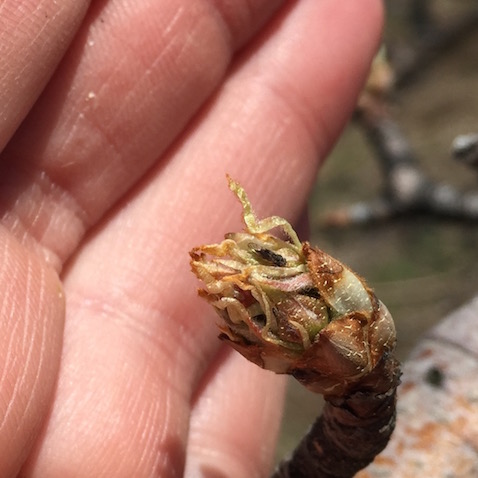 Pear psylla adult start laying eggs in the spring before bud break -- a good oil spray at this timing is the start of your defense against this pest |
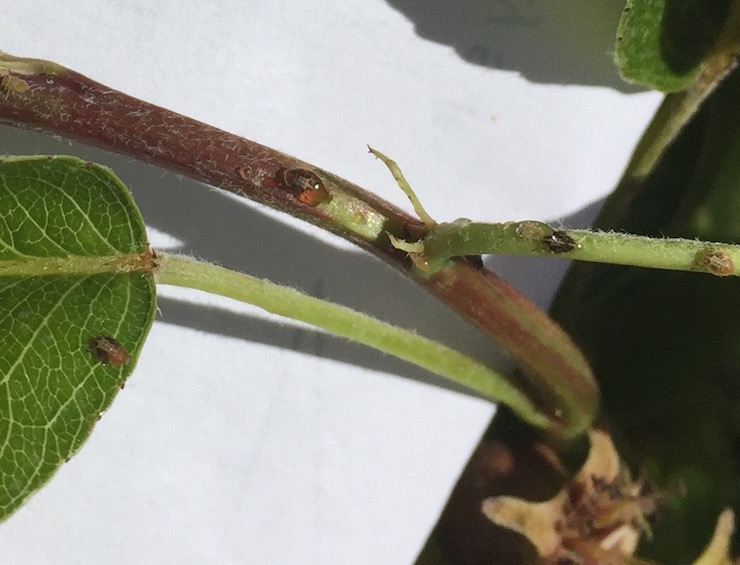 Pear psylla nymphs actively feed on tender pear shoots throughout the growing season if adult egg-laying is not stopped -- these guys are tough to deal with, a systemic insecticide such as Movento or Sivanto is your best bet; in addition, adult egg-laying continues, so summer oil sprays can inhibit that
Pear psylla nymphs actively feed on tender pear shoots throughout the growing season if adult egg-laying is not stopped -- these guys are tough to deal with, a systemic insecticide such as Movento or Sivanto is your best bet; in addition, adult egg-laying continues, so summer oil sprays can inhibit that |
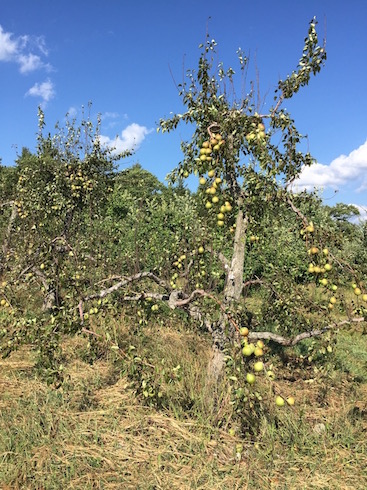 Pear psylla left unchecked results in a real mess -- sooty mold from their honeydew all over the fruit and foliage, and early defoliation; beginning in mid-summer, removal of water sprouts can help the situation |
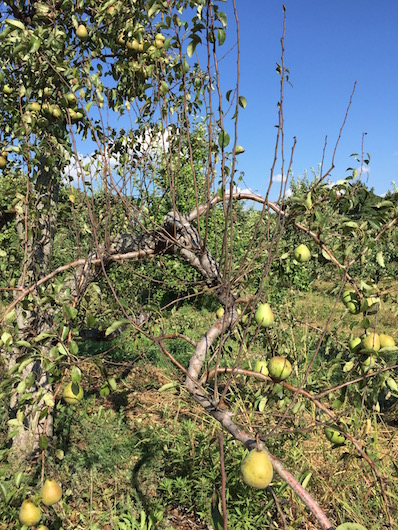 Close-up of early defoliation as a result of pear psylla infestation |
Dan Cooley and Jon Clements
• Dry weather is the story here, as it does not favor disease development. Maintain fungicide coverage for summer diseases as necessary, but spray intervals can be significantly extended w/o rain. But don't go any longer than 14-21 days between sprays.
• Nice (if you are a plant pathologist) cedar apple rust lesions were interestingly noted on the foliage of Calville Blanc apples planted this spring. Too late to do anything now, nor is it particularly a problem, but apple varieties differ significantly in their susceptibility to rust diseases: http://articles.extension.org/pages/60628/cedar-apple-rust
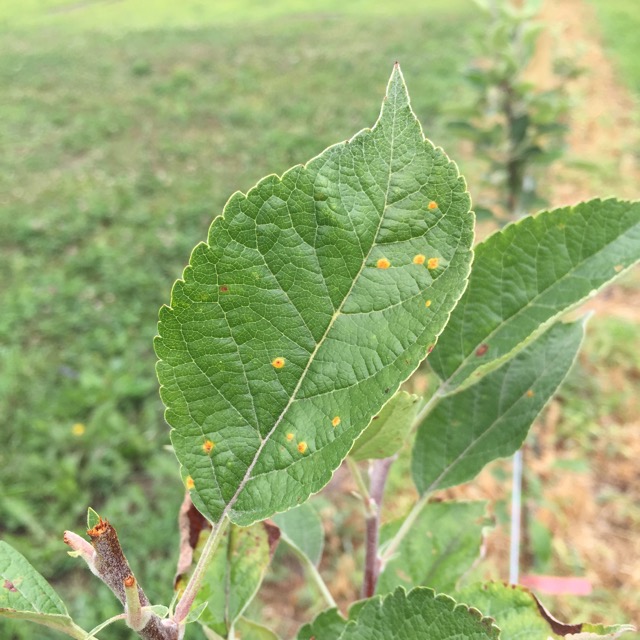
"Nice" cedar apple rust lesions on Calville Blanc apple foliage, 9-July, 2016
(note that it did not deter the deer from feeding either)
J. Clements
• Summer NAA sprays for return bloom should be ongoing; ditto for calcium sprays (for improved fruit quality and storability); hand-thinning and tree training should be done, but could be finished-up; summer pruning could begin and continue until mid-August; what else is there to say???
• Please read Resistance Management: Codling Moth. It's an interesting read...
Follow me (jmcextman) on FB: https://www.facebook.com/jmcextman
• No YouTube video this week.
UMass Fruit Advisor: http://umassfruit.com
Scaffolds Fruit Journal: http://www.nysaes.cornell.edu/ent/scafolds/
Network for Environment and Weather Applications (NEWA): http://newa.cornell.edu
Follow me on Twitter (http://twitter.com/jmcextman) and Facebook (http://www.facebook.com/jmcextman)
The next Healthy Fruit will be published on Tuesday, August 2 (or thereabouts), 2016. As always feel free to get in touch with any member of the UMass Fruit Team (http://extension.umass.edu/fruitadvisor/team-members) if you have questions or comments.